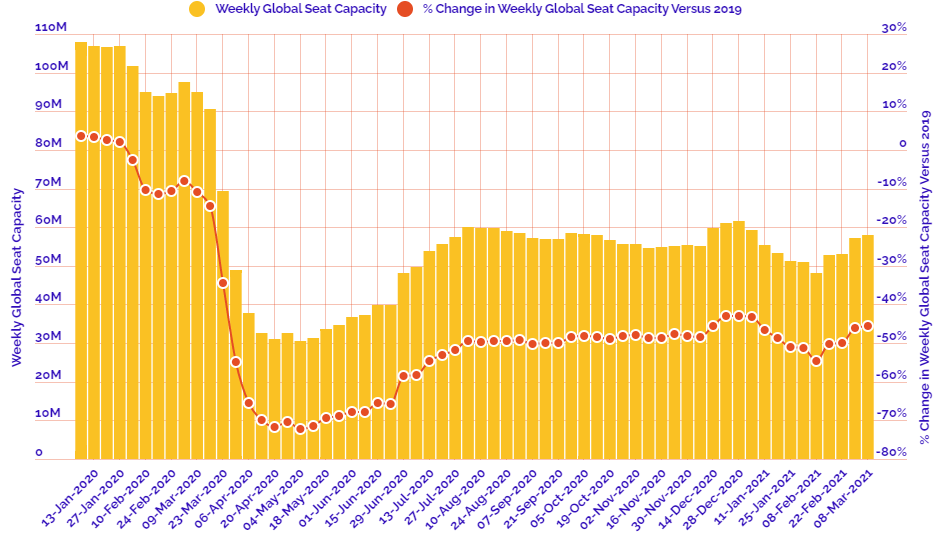Business travellers easily become the envy of those with more mundane roles as they idealise the jet-set lifestyle that they seem to enjoy. In reality, frequent travellers often see things very differently. Those memorable visits account for just a small faction of a life that mainly involves living out of a suitcase in lonely hotel rooms or sat in airport terminals awaiting another delayed flight.
Regular travel can have serious effects on a person's health and wellbeing with experts showing proof it can lead to a poor diet, lack of exercise and excess drinking, while jet lag can induce mood changes, disorientation, disturbed sleep, daytime fatigue and gastrointestinal problems.
Duty-of-care considerations have become a priority for employers and travel programmes have evolved in recent years to ensure itineraries more effectively take into account of traveller needs. Whether that is more direct flights, more convenient hotels with quieter floors and business-oriented offers, or even allowing them an extra night at the destination pre or post the reason for their travel, a range of factors are now considered by travel managers.
However, a new survey from global travel and operational risk firm, Anvil Group, suggests that much more needs to be done. Interviewing over 500 frequent travellers at large global US and European firms to understand the effect that global mobility has on those employees who play a pivotal role in the future success of their organisations showed clear areas of concern.
Most notably it revealed worrying findings about the failings of many organisations to support their globally mobile workforces and a stark warning that companies need to address fundamental flaws in their travel risk programmes if they're to retain key personnel and deliver vital post-pandemic business growth.
Less than a third of respondents (28%) said they were fully able to perform at their best while away on business, just two in five (39%) thought that their travel technology was fit for purpose, while over half (56%) believed there lack of performance while travelling adversely affected their international projects.
Alarmingly, approaching two-thirds (63%) felt they were not fully prepared to take quick action and return to safety, or to recover emotionally, when incidents happen, and over half (51%) said they were ready to leave if support didn't improve.
Prior to the pandemic, this 'Dynamic Workforce' - a term coined by Anvil Group to describe this highly mobile group of employees - routinely worked worldwide on pivotal projects, establishing essential overseas operations, forging cross-border relationships and winning business in new markets.
As such, they will be among the first to return to business travel and international assignments as restrictions start to ease. Given the nature of their roles they should be used to experiencing security, travel, service and medical incidents while away on business, yet the survey findings reveal that their organisations are "routinely failing to provide them with the support they need to succeed - to the detriment of personal performance and their organisations' growth prospects," according to Anvil Group's research.
The results of the survey are a stark reminder that organisations need to address some fundamental flaws in their broader travel risk management programmes and the ongoing support provided to key personnel.
In international firms, responsibility for workforce resilience generally sits across four stakeholder groups: security, travel, HR and medical. But all too often, "these departments work in silos," says Anvil Group in its 'Fit for Growth: Building a resilient and valuable travel risk programme for COVID-19 and beyond' paper based on the survey findings.
This, it says, "creates gaps, conflicts and overlaps" which "impair the quality of support given to dynamic workers" and as a result "damages their confidence in the company's ability to look after them". The survey research illustrated this:

Similarly, while around three quarters of dynamic workers (73%) feel well protected physically while travelling abroad, according to the research, many still express concerns about their mental health and emotional wellbeing, identifying a lack of care for their psychological health, compared to their physical safety.

As Anvil Group notes, "today, the world is increasingly unpredictable, creating more insecurity for anyone doing business internationally". Before COVID-19's arrival we were already failing in duty of care obligations with staff. It is not about reinventing the wheel, but now, more than ever, we need to ensure programmes are adapted to ensure the lifeblood of the business is protected.
They say 'a picture paints a thousand words'. In this regular section CTC - Corporate Travel Community offers a graphical insight into a key industry observation or trend. In this latest edition we look at Anvil Group's 12 section pathway for organisations to help determine if it's the right time to recommence travel and international assignments - underpinned by the principles of flexibility, integration, responsiveness and empathy.
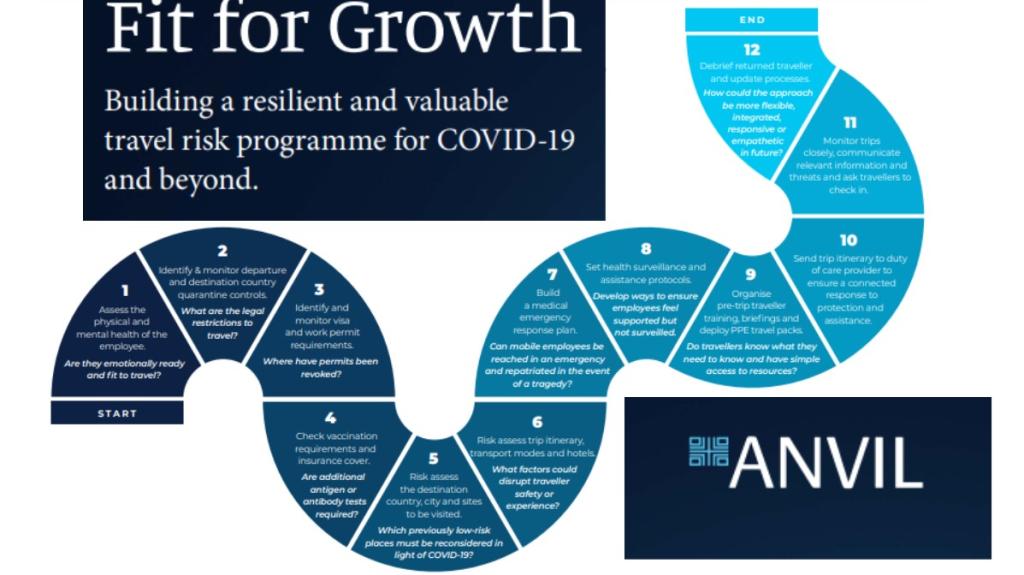
This regular section also now incorporates and expands on the charts produced in the 2020 air capacity series 'Coronavirus Statistics Snapshot'. These are based on an analysis of OAG schedule data and include a weekly look at how the pandemic is impacting global flight levels in the world's largest markets; a week-on-week and year-on-year comparison of flight departures by geographical region and a look at how weekly capacity is trending: the latter comparing levels to 2020 and also to the 2019 baseline performance.
HEADLINE FIGURES FOR WEEK COMMENCING 08-Mar-2021:
Departure frequencies up +1.79% versus last week; down -37.99% versus 2020 and down -43.65% versus 2019.
Seat capacity up +1.39% versus last week; down -38.97% versus 2020 and down -45.56% versus 2019.
CHART: Week-on-week change in flight departures by region
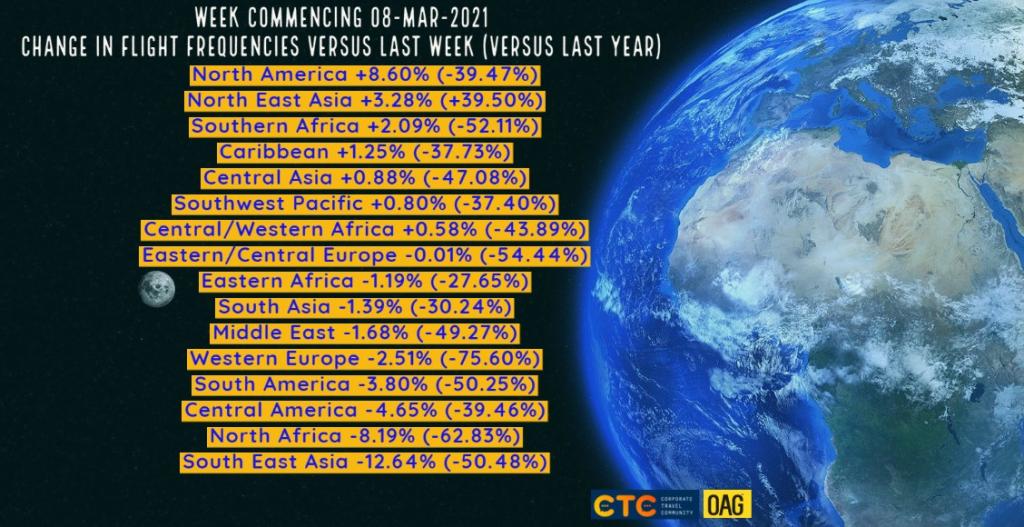
CHART: Year-on-year weekly departure performance for world's top 30 markets versus 2019

CHART: Year-on-year weekly departure performance for world's top 30 markets versus 2020
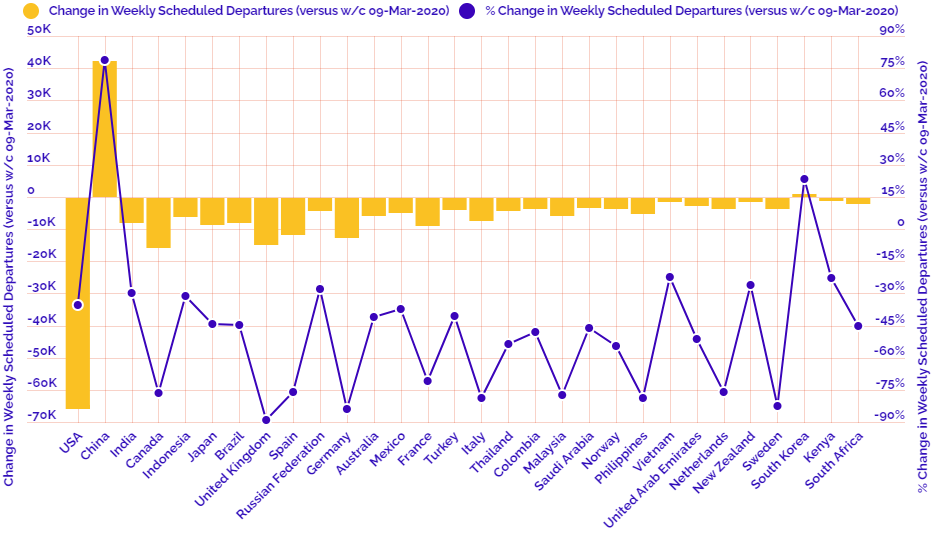
CHART: Departure capacity trends with year-on-year performance
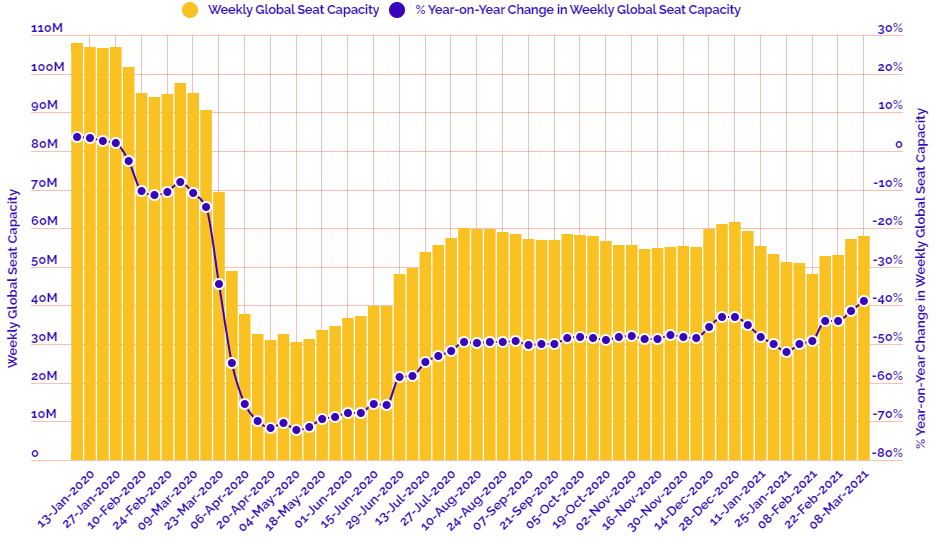
CHART: Departure capacity trends versus 2019
